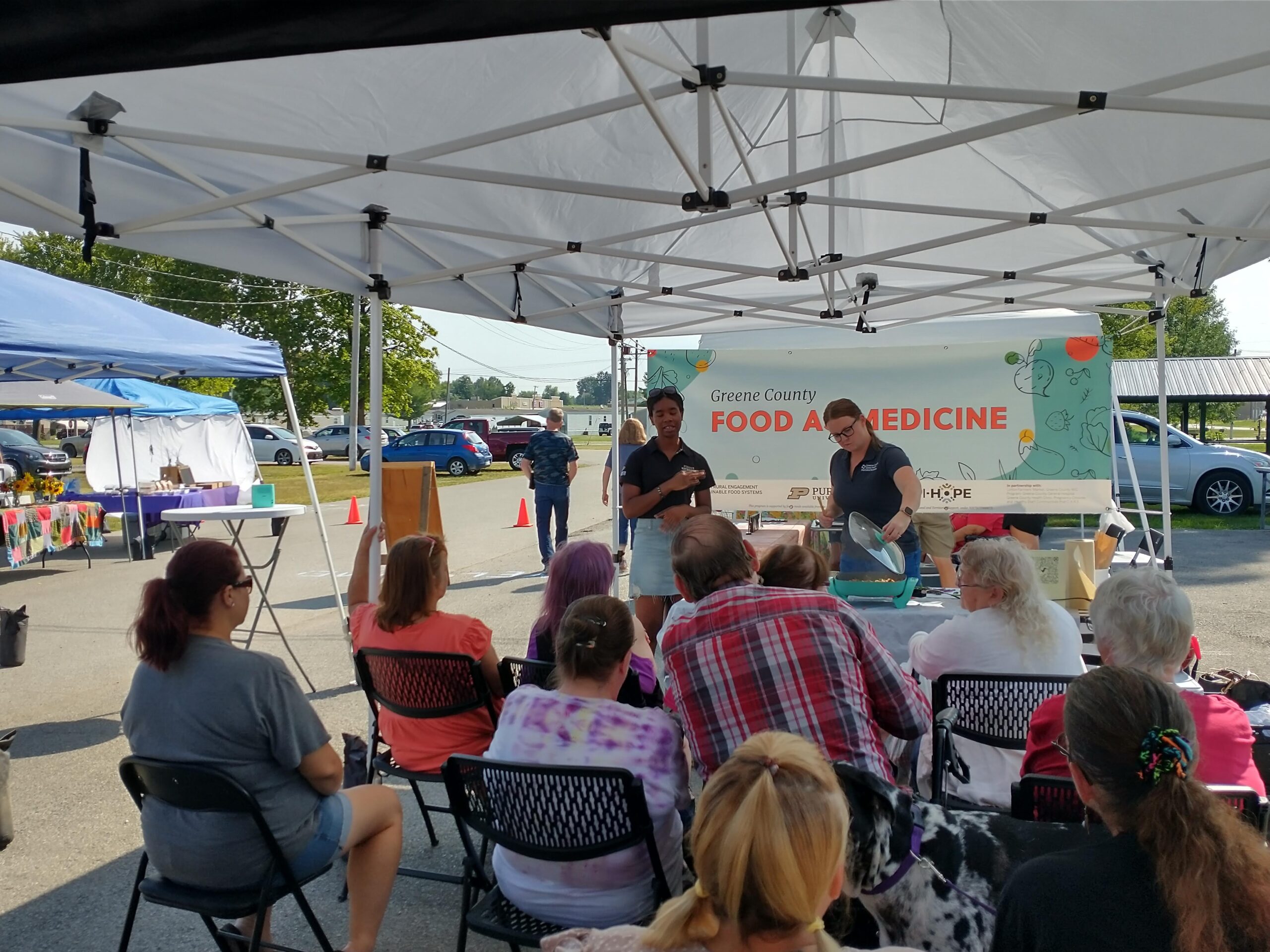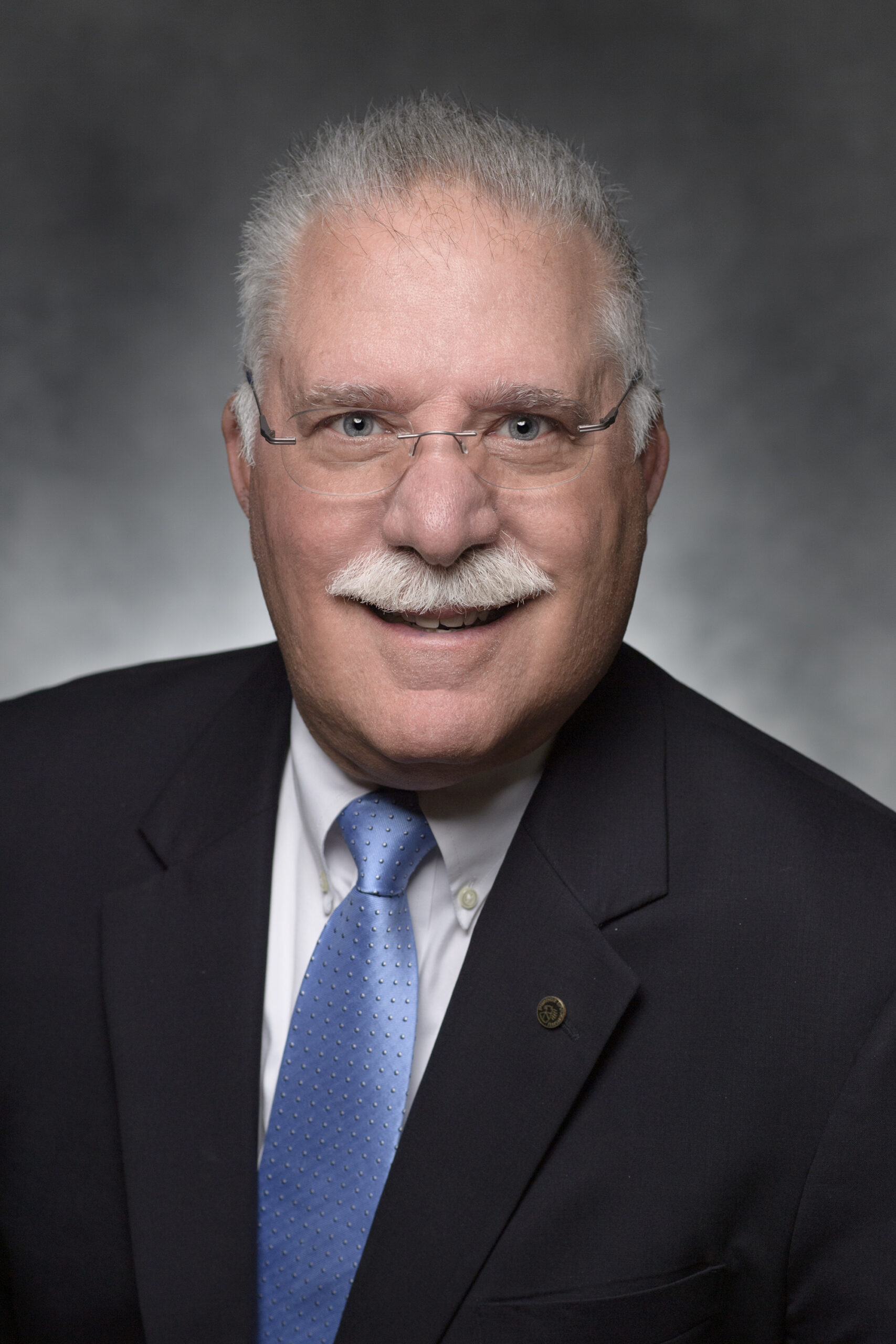Purdue HHS researcher: Less ‘sludge,’ more ‘nudge’ to combat diabetes in Indiana

Ody Ekwonwa, standing and left, leads a Food as Medicine program in Greene County, Indiana. It’s one of multiple programs Purdue University College of Health and Human Sciences Extension leads around the state that aims at reducing type 2 diabetes rates in Indiana.Photo provided
Written by: Tim Brouk, tbrouk@purdue.edu
When it comes to fighting diabetes in Indiana, Hoosiers need more “nudge” than “sludge.”
The sludge consists of barriers to healthy lifestyles, according to Dennis Savaiano, Purdue University Virginia Claypool Meredith Professor of Nutrition Policy in the Department of Nutrition Science. This comes in the form of food deserts that deny residents of healthy nutrition, overworked families where fast food is too often the go-to option and lack of access to health clinics to monitor their lifestyle.

Dennis Savaiano
Conversely, nudges toward healthy lifestyles come in the form of a new bike path in your neighborhood; universities, such as Purdue, where most staff, students and faculty must walk on a typical day; convenient health centers; or access to community programs and organizations that educate stakeholders. Even the month of November is an annual nudge, as it is also National Diabetes Month.
“The easier we make it, the more we’re likely to be successful,” said Savaiano, who also serves as director of the Purdue Clinical and Translational Sciences Institute and Connections IN Health. “One of the key issues is raising health awareness in communities and in society in general. One of the things I think we really try to teach our students is how important (individual) health is to the overall health of the society. Physical and mental health are essential to a healthy society.”
Purdue College of Health and Human Sciences (HHS) faculty like Savaiano research diabetes’ effects, but Savaiano believes engaging with the community is crucial when it comes to preventing and treating Type 2 diabetes. According to Healthline, about 1.4 million Americans are diagnosed with the disease every year. More than 37 million Americans currently suffer from diabetes, according to the Centers for Disease Control and Prevention.
Savaiano considers Type 2 diabetes a public health matter. Exercise and a healthy diet dominated by fresh fruit and vegetables are the most effective ways to keep the disease at bay. But preaching that from an ivory tower or government agency is not going to reach everyone. With help from HHS Extension and health coalitions that have been established, intervention must be more direct.
Rural sludge
Rural counties in Indiana often have high rates of diabetes, Savaiano said. One cause is geography — employment far away from the home and the lack of cities of some size. The town of Newport, for example, rests between Terre Haute, Indiana, and Danville, Illinois. This means, if someone in Newport, which had a population of 416 in 2020, wants fresh produce, they must drive 33 minutes to Terre Haute or 30 minutes to Danville. Mix in work and family schedules, stopping at the fast-food drive-thru down the road is tempting.
“We want to make healthy choices the easy choices, but for many people, the healthy choices are the hard choices,” Savaiano said.
The same challenges exist for rural Hoosiers keeping up with physician exams. If there are no healthcare clinics nearby, driving 30-plus minutes and then 30 minutes back could be difficult or even impossible if their jobs don’t allow them time off without docking pay.
“You’re looking at a half a day’s work missed,” Savaiano said. “It’s a real disincentive to not have easy access. People who live in rural Indiana, on average, drive an hour to an hour and a half back and forth to work every day because they have to commute. So, you end up with a commute problem. The commute problem exacerbates the health access and the food access.”
Dining with Diabetes
HHS Extension nudges Hoosiers toward a healthier life in every Indiana county. Dining with Diabetes is just one program implemented in numerous locations to improve the health of Hoosiers. The events invite community members affected by Type 2 diabetes to learn the benefits of a healthy diet, cooking tips and recipes.
In 2018, 12.5% of Indiana’s population was diagnosed with diabetes compared to the national average of 10.9%, according to the Indiana Department of Health. Jamie Jo Lowder, HHS Extension educator based in Owen County, works in one of the areas with the highest diabetes rates in Indiana. Owen County has the seventh-highest prevalence of diabetes at 17.2%. Switzerland County is the highest at 21.3%, according to Data USA.
Lowder presented two Dining with Diabetes programs this fall, which consisted of four weekly classes. Each session focuses on a topic relevant to people with diabetes: the basics of diabetes, carbohydrates and sweeteners, fats and sodium, and physical activity.
The content from the session is then applied to food demonstrations that are part of the program. Participants learn how to make small changes to various dishes by reducing the carbohydrates, lowering the fat and sodium, or practicing different food preparation techniques for desserts, main dishes, side dishes, and snacks and appetizers.
After the presentation, diners get to sample dishes like lemon mousse, parmesan-crusted chicken and white chocolate orange pudding, which are prepared using healthier cooking options. They are given recipes to take home and try out for themselves.
“We really promote that it’s your choice. It’s your choice to make those decisions to be healthier,” Lowder said. “Nobody’s going to be able to make you do it. It’s all about your choice and doing what your (healthcare) provider says and things like that.”
Three months after the last session, Diners attend a reunion to share stories and results of healthier eating and more active living. But Lowder didn’t have to wait 90 days to hear positive enthusiasm from clients. A woman was ecstatic to lose two pounds between Dining with Diabetes’ first session and its third.
“She was feeling the best that she’s felt in a long time and her blood sugar levels were lower than what they had been in a while,” Lowder beamed. “It was a good success story.”
Healthier Hoosiers everywhere
Lisa Graves, HHS Extension assistant program leader, announced a new Extension initiative to promote healthy habits that challenges Hoosiers to keep diabetes at bay. Just in time for Thanksgiving, an email campaign went to thousands of Hoosiers with Type 2 diabetes or their caregivers. The content of the blast extols the virtues of healthy living as a treatment to manage and shield against Type 2 diabetes. It’s yet another nudge from Purdue HHS to Hoosiers all over.
“It has a call to action where we work with the participants to set a goal for themselves over four weeks,” Graves said. “Sometimes short-term goals can be very impactful for people in terms of making small changes that can help them manage their diabetes.”
Discover more from News | College of Health and Human Sciences
Subscribe to get the latest posts sent to your email.